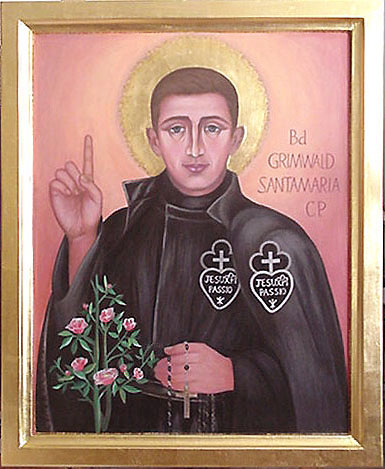Bl. Grimoaldo

Bl. Grimoaldo Santamaria C.P.
The Icon is at Holy Cross Church, where Bl. Grimoaldo’s family attended in Rochester, New York. The dedication ceremony was January 29, 2002, the seventh anniversary of his beatification.
Father McNamara had assisted those working on the cause for Bl. Grimoaldo’s sainthood, and he, with the “Friends of Bl. Grimoaldo”, commissioned the icon, which was painted by Minhhang K. Huynh.
(1883 -1902)
Holy Sepulchre Cemetery in Rochester has long been proud to entomb the remains of the mother of a great Irish leader. Eamon de Valera, successively premier and president of Ireland, was the son of Mrs. Catherine Coll de Valera Wheelwright (1858-1932), a resident of the Flower city.
Now, since January 29, 1995, the Cemetery has been able to boast of enshrining the mother and sister of a saint. On that day Pope John Paul II beatified Blessed Grimoaldo Santamaria, a young seminarian of the Passionist Order.
Grimoaldo, the firstborn child in his family, was the son of Pietro Paolo Santamaria, a rope-maker of Pontecorvo, Italy, and his wife Cecilia Ruscio Santamaria. Born on May 4,1883, he grew up in a devout family of average means. Baptized Ferdinando, he was different from the rest of the Santamaria siblings in that from age six onward, he showed an extraordinary bent towards prayer and all that was religious. Apart from prayer and self-denial, his mother used to say of him, “Nothing else was important.”
This devotion hardly escaped the townsfolk. He puzzled them but they admired him. For all that, Ferdinando remained a thoughtful and likeable boy.
Pietro Paolo trained his oldest child in the craft of rope-making, intending that he would carry on the family business; but the lad marched to a different drum. When 13, he announced his desire to join the Passonist Order of preaching priests. His father, disappointed, delayed for some months before giving his approval.
On Ash Wednesday 1899, Ferdinando left home and family for good, aged 15. The Passionists received him with joy at their novitiate in Paliano, some 40 kilometers from Rome. They clothed him in the heavy, brownish-black habit of their Congregation of the Passion. In honor of the patron saint of Pontecorvo he took the religious name of Grimoaldo of the Purification of the Blessed Virgin Mary.
A year later, on March 5, 1900, he was allowed to take his vows to practice poverty, chastity and obedience, and to preach, in particular, devotion to the passion of Christ. Then he was assigned to their monastery at Ceccano to begin his studies for the priesthood.
Although Grimoaldo was of strong physical constitution, God did not permit him to become a priest. He died on November 18, 1902, of a sudden attack of meningitis and erysipelas, perfectly resigned to the divine will.
Young Santamaria had predicted the hour of his death, and the death shortly afterward of his fellow Pontecorvite, Cardinal Aloisi Masella. As a boy he had been observed on one occasion when at prayer, to be lifted up in ecstasy a foot or so off the ground. But these were his only unusual charismatic gifts. His holiness was rather that of a person who tried consciously to give himself wholly to God, not only in prayer but in trying to do all the small things of life with absolute perfection. That is an approach to holiness that is a little easier for most of us, young or old, to take.
In the 1950s, the Italian Passionists started a campaign to canonize their 19-year-old Brother. His sister Vincenzina (Mrs. Anthony) Panella had come to Rochester to live some years after Grimoaldo’s death. His widowed mother Cecilia had taken up residence with her in 1920. The Passionists asked Vincenzina (“Jenny”) to promote devotion to her brother in Rochester. She was able to tell her friends much about Grimoaldo, from her own memories and the abundant memories of her mother, who had died in 1934.
When the cause for canonization was formally opened in 1957, Jenny and two other Rochesterians from Pontecorvo became important witnesses. In 1991, Pope John Paul II declared him “venerable” as a practitioner of heroic virtue.
Two nieces from Rochester and a number of relatives were present at the beatification.
The whole diocese of Rochester rejoiced. Though he lived and died in Italy, Bl. Grimoaldo, through family ties, can be considered an honorary Rochesterian. Indeed, the Mayor of Rochester officially declared him so.
--Father Robert F. McNamara